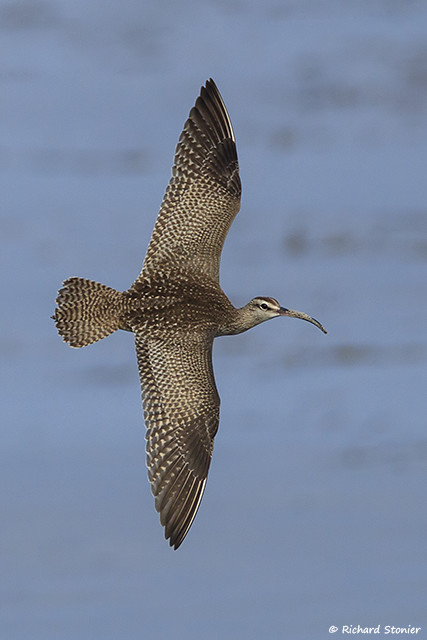Continues from Part I.
My first foray into the Scilly fields after a five-month absence produced a Richard's Pipit — followed by absolutely nothing for the next two and a half weeks. Easterly winds are one thing, but coming off a high pressure in glorious sunshine they are a catalyst for stalemate. It was excruciating. Yet, invariably, I was up at 5 am every morning, pacing the floor, waiting for the light to come up. Unable to contain myself, I went out too early each morning and my silhouetted figure was often to be seen prowling about in semi-darkness by birders still breakfasting in their cottages. What on Earth are you expecting to find at that time of day, said one. Houbara Bustard? Without fail, I was a spent force by 10 am, returning to the cottage for the remainder of the day reading novels on the couch, such was the stultifying atmosphere hanging over the island. Even the massive number of Yellow-browed Warblers I predicted would be filtering down from the Northern Isles and that would be suited to these anticyclonic conditions failed to materialize: the odd one or two, but that was all.
Our slim hopes were kept alive by the forecast arrival of Hurricane Joaquin, yet at the last minute a fork in the Jet Stream caused it to veer off and miss us, though not without giving us some cloud cover that lead to a Little Bunting, another Richard's Pipit, a Red-backed Shrike and a Red-breasted Flycatcher dropping out of the skies in pretty quick succession.
I was supping coffee with friends at Coastguards in mid-morning on the 11 October when news came through of a Red-flanked Bluetail at Covean, found by Doug Page. A wave of euphoria passed over me — at last a bird on the island worthy of the headlines. I didn't need to see it: it was just brilliant it was there. The shackles were off. I was the second person to see it, since it had turned up in my employer's fields and I was able to whizz round and see it before making arrangements for others to come and see it. Everyone was happy again.
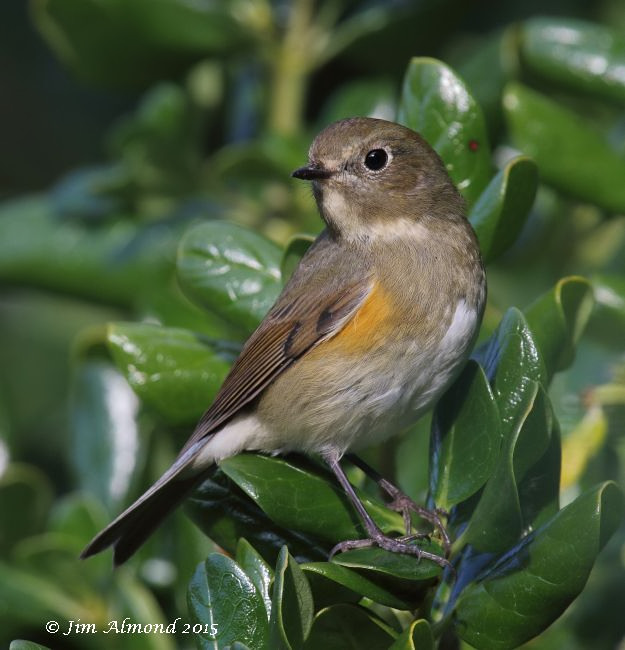
Red-flanked Bluetail, St. Agnes, Isles of Scilly (Photo: Jim Almond)
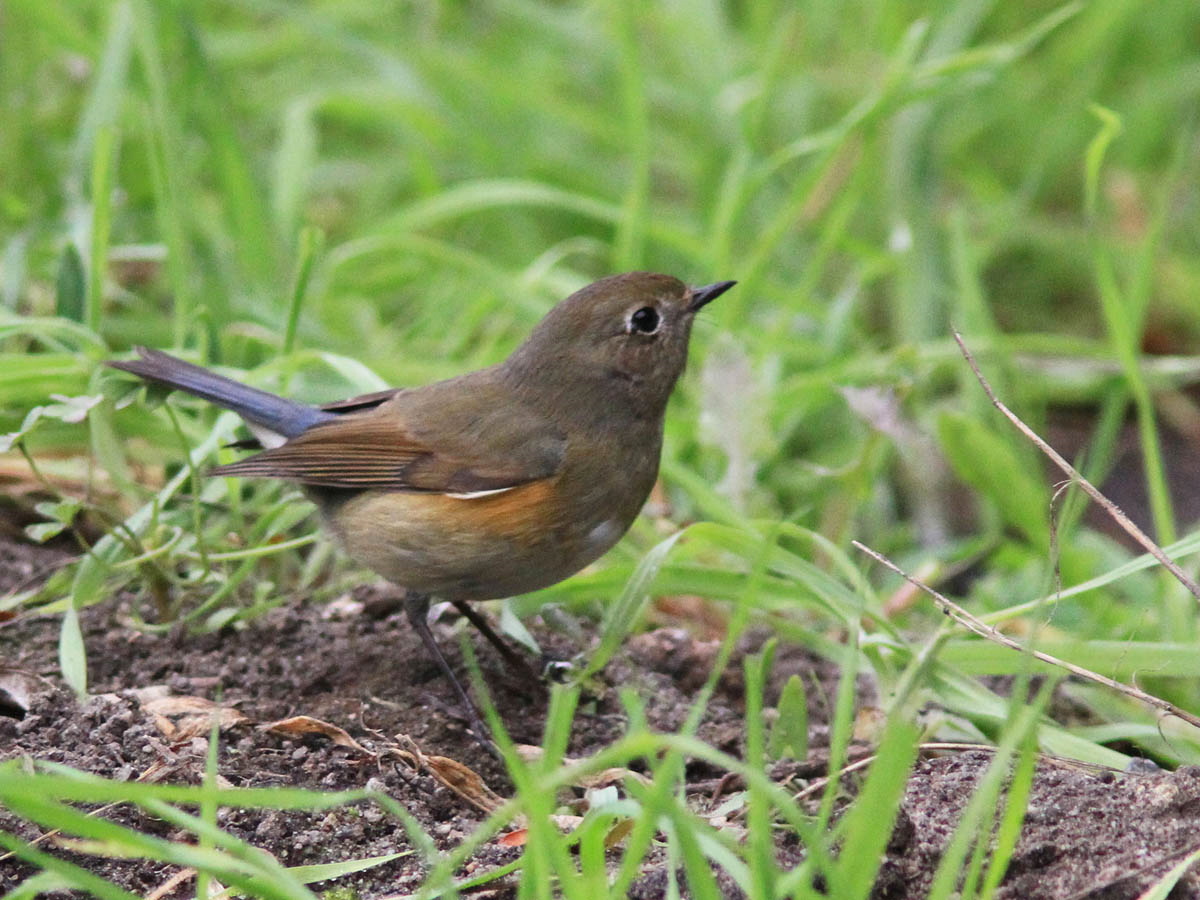
Red-flanked Bluetail, St. Agnes, Isles of Scilly (Photo: Cliff Woodhead)
On its third morning I came round a corner and stumbled into it at point-blank range on the footpath in front of me. There we were eye to eye: the most intimate encounter of the 50 or so Bluetails I've seen worldwide. Then suddenly I noticed it quiver its tail in a manner I associate more with Siberian Blue Robins and in a flash it dawned on me, quite horribly, that I'd seen this bird before. Obviously, yes, I'd seen it in the previous two days but in that moment with total recall, to my utter chagrin, I remembered a semi-conscious encounter with a passerine in the fields next to my house at Lowertown Farm the morning before. In the half-light a silhouette, slim against the grey dawn sky, turned away from me, showing no obvious red breast. I'd considered it for a split second and then diverted my attention to some other momentary distraction nearby. I'd seen the tail shiver ever so subtly but had barely registered its significance consciously until now. This subconscious mind of mine that had previously heard Scilly's first White-throated Sparrow call before my conscious, awake mind had realized it (2010) had spotted this tail movement, but the everyday me hadn't fully grasped the implication. I'd looked back, the bird had dropped off its exposed perch, flown behind a hedge, and I'd gone through the motions of pursuing it for half a minute — realizing I hadn't totally written it off as a Robin — but moving on all the same. The moment was lost and forgotten about, until I saw that tail movement at Covean.
I'm aware that all this sounds a little stringy to an outsider and I don't know 100 percent whether this was the Bluetail, as I do with the heron, but I think it was. Having found a male Rubythroat — sorry, had to stick that one in to cheer myself up here — and indeed having had the current Bluetail make me so happy, I went about my business during the day laughing off this second faux pas of the year quite easily. I was pleased for Doug that he had found it. But in the dark, as I woke up in the early hours of the morning, that first encounter kept replaying itself in my mind for the next two or three days. Oh no. How could I have been so careless again! In self-mitigation I can offer that the migrant famine of the previous fortnight had dulled my senses and left me mentally unprepared for what would have been (if it had been the Bluetail) the first to break the fast. With nothing to look at previously I was starting to find minor faults with my 15-year-old binoculars that may or may not have been illusion, worrying about failing eyesight and lack of complete 'at one' collusion between eyes, binoculars and brain. Like a striker in a goal drought, I'd missed a definite half-chance.
But wait, it gets worse! Much worse in a way... if the heron and the Bluetail had mitigating circumstances of dodgy light and background distractions (and they do) — this next one doesn't at all...
It's a lovely, sunny start to the day and the Isles of Scilly are looking at their absolute best, the sort of morning that makes you glad you came here, no matter what birds you see or don't see. I'm awake now and I'm out properly on the prowl, which for me means zipping around quickly, hands in pockets, just waiting for that something to fly out in front of me, or maybe call and draw my attention to it. It's not what you would call a thorough approach, but it's worked for me plenty of times in the past and so I back myself to just do what I do. A Whimbrel is perched prominently on the highest point of Browarth, behind the Big Pool. You don't often get the chance to look at a Whimbrel this boldly standing out in the open on St Agnes — they're usually creeping about unobtrusively in the dark seaweed- covered rocks and only visible when you flush them or hear one call. This one is just standing there, positively shouting out 'look at me, look at me'. So I do. I spend a good five minutes grilling it from some 60 yards through my binoculars. It's really quite lovely. The sun's at my back, picking out its fresh feathers beautifully and I realize I haven't enjoyed a Whimbrel as good as this for years. I realize, of course, that it might be worth checking its rump for Hudsonian Whimbrel since I've never seen one in the UK, but it's not really something I've ever had designs on finding, to be honest. And besides, once again the wind has been determinedly in the east for the best part of three weeks now; there are no American waders anywhere in the UK as far as I know. So I'm not really that bothered, to tell the truth; I debate with myself for a good minute or so whether I'm going to go out of my way to dislodge this bird to see its rump, until I come to the conclusion it would be too much hassle for both of us and why spoil the occasion by being so rude. After all, I have been known to take a circular route to avoid flushing Song Thrushes and Blackbirds that are feeding contentedly on the footpath at Periglis Ridge and who seem disinclined to get out of my way. So I leave it and walk on.
Less than three hours later a Hudsonian Whimbrel turns up on Tresco and I know, I just know in that moment I've messed up again! It was true there had been a (Eurasian) Whimbrel around Browarth for a week or more previously — I'd seen it myself a couple of days before. But normal Whimbrels simply don't pose like that here on St Agnes. (They're practically ever present here from July through to May, one or two wintering most years.) There had been something different about this bird — I just knew it... now. It had just been too well marked, too perfect a head pattern, there had just been something about it, the length of its bill, the extensive pale base...? I don't know. There had just been something about it.
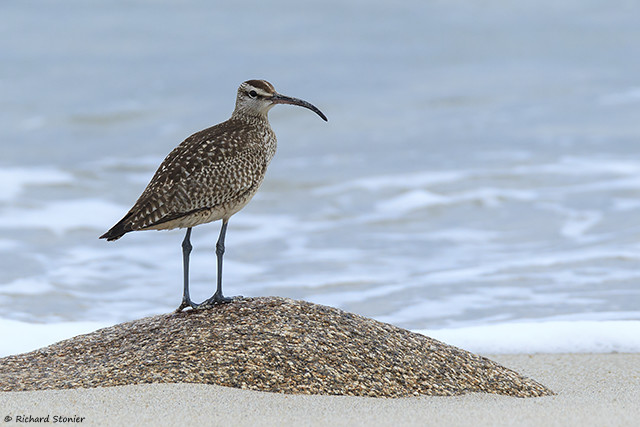
Hudsonian Whimbrel, Tresco, Isles of Scilly (Photos: Richard Stonier)
Unlike with the Great Blue Heron, I wasn't too fussed about going to Tresco to see the Hudsonian Whimbrel for whatever reason. They weren't really invented when I was a boy and I'd never got round to mustering a desire to see one in the UK since then. That didn't mean I wasn't in an extended state of self-recrimination at the moment, though. The first pictures that I saw back from Tresco put my mind at rest for a short while. They weren't particularly good photos but they seemed to show a bird with an all-dark bill, unlike the one I had seen with an extensive flesh base. But when I saw the proper photos by the pros, there could be no doubt about it — it had to be the same bird. I hunted down the Eurasian on Browarth to try to convince myself otherwise, but it was a tatty, unattractive bird with a subdued head pattern, a mostly dark bill and it was typically furtive and difficult to see. Take my word for it, the hat-trick of faux pas on St Agnes for the year was complete — though, as in the case of the heron and bluetail, this too had a happy ending since I was able to see it (and actually thoroughly enjoy it) on the beach at Marazion when I ventured off Scilly to the mainland in early November. My views through the scope at close range confirmed all the details I noted on my five-minute appreciation of it on Browarth three weeks before. If I could actually claim it for my 'finds list' — which I don't incidentally, and neither do either of the other two count — it would have gone on to become my longest-ever staying rarity. But it isn't, it just wouldn't be right.
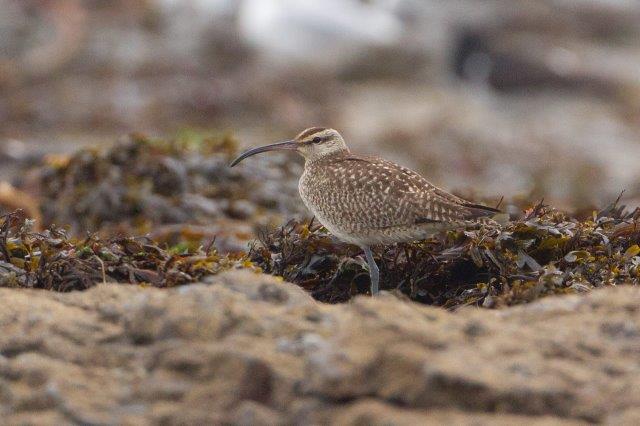
Hudsonian Whimbrel, Marazion, Cornwall (Photo: Dave Rimes)
Now I'm finished with the dark, dodgy stuff, I'm going to round off with a happier note — or notes, I suppose. Because, 36 hours after the Covean Bluetail was last seen, I came across one on the other side of the island that all who saw it and photographed it agreed was a different one. Since I have a lengthy description to make for the Rarities Committee I won't go into detail here, except to say it became a 'garden tick', though whether I'm happy with it as a 'find tick' is a matter of personal debate. A Bluetail was seen earlier in the day along Barnaby Lane that was simply assumed to be the original bird relocating, but my gut feeling is that it was the bird that ended up in my garden and on the cricket pitch later that day — 'my bird'. I'm sticking it on my find list because it fits the criteria for the 'surprise' tag though, as I'm discovering increasingly, this personal find list that I thought would eradicate the uncertainty I used to fret over with UK and World lists (dodgy views, escape potential, splits and lumps) has just as many grey areas and is on the verge of becoming obsolete too.
At some point in my internal monologue during the above ongoing shenanigans, it came to me that I would happily offset all of my tribulations if only this would be the year I would finally find a Pallas's Warbler. My mathematical self told me that statistically I was too inefficient in coming across more than one or two of the island's dozen or so Yellow-broweds for this to be a realistic proposition, but these stories have a way of writing themselves sometimes — or certainly with hindsight they can seem to have done. Pallas's Warbler was one of the key species that opened the door for me into the wonderful world of bird migration and long-distance vagrancy when I was a schoolboy during the first Pallas's Warbler 'invasion' of 1982. Even though I managed to miss all five of the birds that were recorded in my home area, the thought of coming across one in easterly winds and mist was a magical and mysterious thing that remained as the backdrop to my subsequent forays for birds in the coastal village of Whitburn throughout the 1980s.
As I grew up through my teens dedicated to my patch, the holy trio of Pallas's, Radde's and Dusky Warbler motivated my obsessional desires like no other birds could. I succeeded in finding one each of the latter pair, the Radde's appearing in my notebook under the headline 'the best day of my life so far', but Pallas's consistently eluded me. Twice I was second observer on Pallas's during that period, one of them turning up in the exact spot I'd been standing for almost an hour earlier in the day. I moved to Ireland, then Scilly, bumping into much rarer birds with 'warbler' in their names: Eastern Olivaceous, Blyth's Reed, Booted, Paddyfield. I came across my second Dusky Warbler and another Radde's, but never a Pallas's.

Pallas's Warbler (Photo: Penny Clarke)
On Fair Isle I found Paddyfield, Lancy, a second and third Blyth's Reed, another Dusky, an Arctic Warbler...but still no Pallas's. I walked past one that later started singing in the garden of the house where I was staying in Ireland, found by someone else. The list of close shaves and near misses was almost in double figures. It became an annual mystery to me: how did they keep eluding me? What would my reaction be when, and if, I should ever locate one? Would it be relief? Would it be simply an aura of inevitability? Disappointment even?
And then came this October 25th. As I sat down to listen to the Everton–Liverpool game on a dank, dreary afternoon, a text came through to tell me a Pallas's Warbler had been found near Troytown. I've been a Liverpool fan for many, many years, but a Pallas's Warbler fan for almost as long, and birding trumps football at least in October. I dashed out hoping to see it. There was only one other birder out looking, Ilya MacLean, the rest having given up for the day, but neither of us saw it. Or at least, I thought so. I found out early next morning that Ilya had in fact glimpsed the bird in the very last vestiges of light, ten minutes after I'd given up on it. A further search of the area that morning also came up blank.
The guy who found the Pallas's, Louis Cross, was a relative newcomer to Scilly and I did not know him. Coming back up Barnaby Lane an hour or so later after a quick look around Covean, I saw an unfamiliar face standing gazing up at the elms and I worked out this must be him. I asked him about his find, which of course he was only too happy to tell me all about. He alluded to the fact the bird was keeping very low to the ground when he first saw it — in fact it had landed on the road in front of him and worked its way gradually into some gorse bushes at the edge of Castella Down just before the road drops into Troytown. I still had hopes of catching up with the bird later in the day and was just in the process of continuing my grilling, when halfway through the sentence I suddenly exclaimed: "Oh there's one!"
And sure enough, there was one. All previous complaints about the lack of co-ordination between faculties and equipment were dissolved in that moment. Forget logic, forget piece-by-piece assimilation of field characters, the combination just hits you all at once. These are the moments we live for: that distillation of past, personal history into one ephemeral yet timeless snapshot of the immediate present. A Pallas's Warbler. A Pallas's Warbler. I've found a flippin' Pallas's Warbler.
I didn't even think about the possibility of its being the bird from yesterday, 500 metres and two and a half farms away from where I was now standing. As I had just ascertained, that bird moved barely more than a few metres in three hours, being seen again last thing at night. This was intuitively a new arrival, no doubt about it. Other birders hurrying along the lane to collect their tenth, or twelfth or twentieth Pallas's or whatever, couldn't comprehend why I was so animated at 'just another Pallas's'.
Well only I can know, until I've told this story. Only I can know what a relief, what a joy it was after what I'd been through during the year, and after 33 autumns of hoping to find a Pallas's. There's no way I would have felt this excited about a Great Blue Heron — not that it was my bird anyhow — as admirable as it was. And finding a Hudsonian Whimbrel would have probably just left me a bit nonplussed, underwhelmed maybe. Finding a triple-exclamation mark rarity may be every birder's dream but my experience with the Pallas's shows it doesn't have to be an ultra-rare that takes you to the heights. The Bluetail? Well that was Doug's; I'm glad it was him. The other Bluetail was just a footnote really, a postscript for the year. It gives me something to look forward to again next year. I got a message later that evening to tell me that the Troytown Pallas's was still present. The two different birds were seen simultaneously in their different locations the following day. I knew they had to be different birds the moment I saw the second one, but confirmation was sweet. Steve Williams discovered a Dusky Warbler right underneath the Barnaby Lane Pallas's Warbler the second afternoon, and so St Agnes went on.
You just have to keep going, don't you?
Isn't birding just brilliant!

